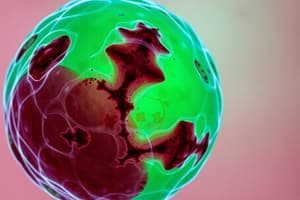Podcast
Questions and Answers
Which of the following is the first manifestation of cell injury?
Which of the following is the first manifestation of cell injury?
- Increased eosinophilia of the cytoplasm
- Reduced oxidative phosphorylation
- Cellular swelling (hydropic change) (correct)
- Fatty change (steatosis)
What causes cellular swelling (hydropic change) in reversible cell injury?
What causes cellular swelling (hydropic change) in reversible cell injury?
- Increased protein synthesis
- Influx of calcium ions into the cell
- Decreased permeability of the plasma membrane
- Changes in ion concentrations and water influx (correct)
Which of the following macroscopic features is associated with reversible cell injury in an organ?
Which of the following macroscopic features is associated with reversible cell injury in an organ?
- Increased weight, increased turgor, and pallor (correct)
- Decreased weight, decreased turgor, and redness
- Decreased weight and increased turgor
- Increased weight and decreased turgor
What is fatty change (steatosis) characterized by?
What is fatty change (steatosis) characterized by?
Which condition is least likely to cause fatty liver in developed countries?
Which condition is least likely to cause fatty liver in developed countries?
What are the microscopic findings in a liver affected by fatty change?
What are the microscopic findings in a liver affected by fatty change?
Which of the following is NOT a cause of fatty change (steatosis)?
Which of the following is NOT a cause of fatty change (steatosis)?
A patient's liver biopsy shows increased weight, increased turgor, and pallor. What is the most likely underlying process?
A patient's liver biopsy shows increased weight, increased turgor, and pallor. What is the most likely underlying process?
Which condition can be directly related to nutritional excesses?
Which condition can be directly related to nutritional excesses?
Which of the following cellular changes is characteristic of irreversible cell injury?
Which of the following cellular changes is characteristic of irreversible cell injury?
What is the underlying cause of necrosis?
What is the underlying cause of necrosis?
Which of the following best describes the cytoplasmic appearance in necrotic cells?
Which of the following best describes the cytoplasmic appearance in necrotic cells?
What nuclear change is characterized by shrinkage and condensation of the nucleus?
What nuclear change is characterized by shrinkage and condensation of the nucleus?
In which type of necrosis is the tissue architecture preserved for several days?
In which type of necrosis is the tissue architecture preserved for several days?
Why does liquefactive necrosis typically occur in the brain?
Why does liquefactive necrosis typically occur in the brain?
What pathological process is associated with malignant hypertension causing fibrinoid necrosis?
What pathological process is associated with malignant hypertension causing fibrinoid necrosis?
What cellular change definitively indicates that an injury has become irreversible?
What cellular change definitively indicates that an injury has become irreversible?
Which of the following is NOT a primary mechanism directly leading to cell injury?
Which of the following is NOT a primary mechanism directly leading to cell injury?
An individual is exposed to carbon monoxide in a poorly ventilated room. Which mechanism of oxygen deprivation is most likely to cause cell injury in this scenario?
An individual is exposed to carbon monoxide in a poorly ventilated room. Which mechanism of oxygen deprivation is most likely to cause cell injury in this scenario?
Which physical agent causes cell injury primarily through energy deposition and ionization of molecules?
Which physical agent causes cell injury primarily through energy deposition and ionization of molecules?
How can hyperglycemia (abnormally high glucose concentration) cause cell injury?
How can hyperglycemia (abnormally high glucose concentration) cause cell injury?
Which type of cell injury is most directly related to the body's defense against pathogens?
Which type of cell injury is most directly related to the body's defense against pathogens?
Which mechanism describes how genetic derangements can lead to cell injury?
Which mechanism describes how genetic derangements can lead to cell injury?
Deficiencies or excesses of which of the following can directly cause cell injury?
Deficiencies or excesses of which of the following can directly cause cell injury?
What is the type of pathological calcification that occurs in diseased or necrotic tissue?
What is the type of pathological calcification that occurs in diseased or necrotic tissue?
Which of the following substances can be considered an endogenous pigment?
Which of the following substances can be considered an endogenous pigment?
In which condition would metastatic calcification most likely be seen?
In which condition would metastatic calcification most likely be seen?
Which of the following is NOT a consequence of increased parathyroid hormone (PTH) secretion?
Which of the following is NOT a consequence of increased parathyroid hormone (PTH) secretion?
What do clear vacuoles in the cytoplasm indicate in relation to glycogen?
What do clear vacuoles in the cytoplasm indicate in relation to glycogen?
Which of the following is a characteristic feature of apoptosis?
Which of the following is a characteristic feature of apoptosis?
Which of the following is an example of a physiologic process involving apoptosis?
Which of the following is an example of a physiologic process involving apoptosis?
What is the primary distinction between necrosis and apoptosis regarding inflammation?
What is the primary distinction between necrosis and apoptosis regarding inflammation?
Which of the following best describes the role of caspases in apoptosis?
Which of the following best describes the role of caspases in apoptosis?
Gangrenous necrosis is most likely to occur in which of the following locations?
Gangrenous necrosis is most likely to occur in which of the following locations?
What distinguishes wet gangrene from dry gangrene?
What distinguishes wet gangrene from dry gangrene?
What is the primary function of autophagy?
What is the primary function of autophagy?
Which cellular process primarily maintains cellular integrity under stressful conditions?
Which cellular process primarily maintains cellular integrity under stressful conditions?
Steatosis is a type of intracellular accumulation characterized by the abnormal retention of:
Steatosis is a type of intracellular accumulation characterized by the abnormal retention of:
Which process leads to cell injury and death?
Which process leads to cell injury and death?
Flashcards
Cell Injury
Cell Injury
A state where cells are stressed beyond their ability to adapt, leading to functional and structural abnormalities.
Reversible Cell Injury
Reversible Cell Injury
Changes in cells are reversible if the harmful stimulus is removed, and the cell returns to normal function.
Hallmarks of Reversible Cell Injury
Hallmarks of Reversible Cell Injury
Reduced ability to produce energy, causing swelling and changes in cell structures.
Cellular Swelling (Hydropic Change)
Cellular Swelling (Hydropic Change)
Signup and view all the flashcards
Fatty Change (Steatosis)
Fatty Change (Steatosis)
Signup and view all the flashcards
Alcohol Abuse & Fatty Liver
Alcohol Abuse & Fatty Liver
Signup and view all the flashcards
Fat Liver (Macroscopic)
Fat Liver (Macroscopic)
Signup and view all the flashcards
Fat Liver (Microscopic)
Fat Liver (Microscopic)
Signup and view all the flashcards
Depletion of ATP
Depletion of ATP
Signup and view all the flashcards
Mitochondrial Damage
Mitochondrial Damage
Signup and view all the flashcards
Calcium Influx
Calcium Influx
Signup and view all the flashcards
Oxidative Stress
Oxidative Stress
Signup and view all the flashcards
Defects in Membrane Permeability
Defects in Membrane Permeability
Signup and view all the flashcards
Damage to DNA & Proteins
Damage to DNA & Proteins
Signup and view all the flashcards
Oxygen Deprivation (Hypoxia)
Oxygen Deprivation (Hypoxia)
Signup and view all the flashcards
Pigment
Pigment
Signup and view all the flashcards
Exogenous Pigment
Exogenous Pigment
Signup and view all the flashcards
Endogenous Pigment
Endogenous Pigment
Signup and view all the flashcards
Dystrophic Calcification
Dystrophic Calcification
Signup and view all the flashcards
Metastatic Calcification
Metastatic Calcification
Signup and view all the flashcards
Necrosis
Necrosis
Signup and view all the flashcards
Coagulative Necrosis
Coagulative Necrosis
Signup and view all the flashcards
Liquefactive Necrosis
Liquefactive Necrosis
Signup and view all the flashcards
Caseous Necrosis
Caseous Necrosis
Signup and view all the flashcards
Fibrinoid Necrosis
Fibrinoid Necrosis
Signup and view all the flashcards
Fat necrosis
Fat necrosis
Signup and view all the flashcards
Gangrene
Gangrene
Signup and view all the flashcards
What is apoptosis?
What is apoptosis?
Signup and view all the flashcards
What are the causes of apoptosis?
What are the causes of apoptosis?
Signup and view all the flashcards
What are the morphological changes during apoptosis?
What are the morphological changes during apoptosis?
Signup and view all the flashcards
Explain the mechanisms involved in apoptosis.
Explain the mechanisms involved in apoptosis.
Signup and view all the flashcards
What are the clinical correlates of apoptosis?
What are the clinical correlates of apoptosis?
Signup and view all the flashcards
What is necrosis?
What is necrosis?
Signup and view all the flashcards
What is autophagy?
What is autophagy?
Signup and view all the flashcards
Why does autophagy happen?
Why does autophagy happen?
Signup and view all the flashcards
What are intracellular accumulations?
What are intracellular accumulations?
Signup and view all the flashcards
What are some common examples of intracellular accumulations?
What are some common examples of intracellular accumulations?
Signup and view all the flashcards
Study Notes
Cell Injury & Death
- Cell injury occurs when cells are severely stressed, unable to adapt, or exposed to damaging agents or intrinsic abnormalities.
Learning Outcomes
- Reversible vs irreversible cell injury
- Necrosis: causes, mechanisms, morphology, and clinical correlates
- Apoptosis: causes, mechanisms, morphology, and clinical correlates
- Distinguishing necrosis and apoptosis
- Intracellular accumulations: clinical significance
- Pigments: exogenous vs endogenous
- Pathologic calcification: dystrophic vs metastatic
Definition
- Cell injury: occurs when cells are severely stressed, unable to adapt, or exposed to damaging agents or intrinsic abnormalities.
Reversible Cell Injury
- Functional and morphologic changes are reversible if the damaging stimulus is removed.
- Hallmarks include:
- Reduced oxidative phosphorylation
- Cellular swelling
- Alterations in organelles
- Two morphological features on light microscopy:
- Cellular swelling (hydropic change)
- Fatty change
Cellular Swelling (Hydropic Change)
- First sign of cell injury
- Caused by changes in ion concentrations and water influx.
- Cells lose their ability to maintain ionic and fluid homeostasis.
- Results from failure of energy-dependent pumps in the plasma membrane.
- Macroscopic features: increased weight, increased turgor, pallor
- Microscopic features: small, clear vacuoles within the cytoplasm and increased eosinophilia of the cytoplasm
Fatty Change (Steatosis)
- Abnormal accumulation of lipid droplets (triglycerides) in parenchymal cells of organs.
- Causes:
- Toxins
- Protein malnutrition
- Diabetes mellitus
- Obesity
- Hypoxia
- Alcohol
- Example: Fatty Liver. In developed countries, alcohol abuse is a primary cause. Other causes of non-alcoholic fatty liver include diabetes and obesity
Irreversible Injury
- With continued damage, injury becomes irreversible, causing cell death.
- Difficult to pinpoint the exact time when reversible becomes irreversible.
- Two phenomena consistently characterize irreversibility:
- Inability to reverse mitochondrial dysfunction
- Profound disturbances in membrane function
Mechanisms of Cell Injury
- Depletion of ATP
- Mitochondrial damage
- Calcium influx
- Oxidative stress (accumulation of ROS)
- Defects in membrane permeability
- Damage to DNA and proteins
Causes of Cell Injury
- Oxygen deprivation:
- Hypoxia (deficiency of oxygen) reduces aerobic oxidative respiration.
- Causes of hypoxia: reduced blood flow (ischemia), inadequate oxygenation of the blood (cardiorespiratory failure), decreased oxygen-carrying capacity of the blood (anemia, carbon monoxide poisoning).
- Physical agents:
- Mechanical trauma
- Extreme temperatures (burns and deep cold)
- Sudden changes in atmospheric pressure
- Radiation
- Electric shock
- Chemical agents and drugs:
- Simple chemicals (e.g., glucose, salt) in abnormal concentrations can directly injure cells or disrupt electrolyte balance.
- Trace amounts of poisons may cause sufficient cell death in minutes or hours.
- Other: environmental and air pollutants, insecticides, herbicides, industrial occupational hazards, recreational drugs, and therapeutic drugs
- Infectious agents:
- Includes viruses, rickettsiae, bacteria, fungi, and parasites
- Serves an essential function in defense against infectious pathogens.
- Immune reactions can also cause cell injury (e.g., autoimmune diseases and responses to pathogens).
- Genetic derangements:
- Deficiency of functional proteins (e.g., enzyme defects in inborn errors of metabolism).
- Accumulation of damaged DNA or misfolded proteins.
- Nutritional imbalances:
- Deficiencies of specific vitamins
- Self-imposed nutritional deficiencies (e.g., anorexia nervosa)
- Excessive intake of nutrients (e.g., cholesterol predisposes to atherosclerosis)
Necrosis
- Definition: The death of tissues following bioenergetic failure and loss of plasma membrane integrity.
- Morphology:
- Cytoplasm: increased eosinophilia, glassy and homogenous appearance, vacuolated or moth-eaten.
- Nucleus: karyolysis, pyknosis, karyorrhexis
- Types: coagulative, liquefactive, caseous, fibrinoid, fat, gangrenous.
Apoptosis
- Definition: A pathway of cell death induced by a tightly regulated suicide program. Cells destined to die activate intrinsic enzymes that degrade their own DNA and proteins.
- Causes: Physiological (destruction of cells during embryogenesis, involution of hormone-dependent tissues, cell loss in proliferating cell populations, elimination of potentially self-reactive lymphocytes, death of host cells), and Pathologic (DNA damage, accumulation of misfolded proteins, cell death in certain infections, pathologic atrophy in parenchymal organs).
- Morphology: cell shrinkage, chromatin condensation, formation of cytoplasmic blebs and apoptotic bodies, phagocytosis of apoptotic bodies, intensely eosinophilic cytoplasm with fragments of dense nuclear chromatin.
- Mechanisms:
- Two pathways: intrinsic (mitochondrial) and extrinsic (death-receptor mediated)
- Two phases: initiation and execution
- Clinical correlates: decreased apoptosis (malignancy, autoimmune diseases), increased apoptosis (neurodegenerative diseases, death of virus-infected cells).
Autophagy
- Definition: A process in which a cell eats its own contents.
- Can be physiological or pathological
- Examples of physiological autophagy: aging, exercise, atrophy
- Examples of pathological autophagy: cancer, neurodegenerative diseases, infectious diseases, inflammatory bowel diseases
- Maintains cellular integrity under stress conditions.
Intracellular Accumulations
- Accumulations of abnormal amounts of substances within a cell (cytoplasm, nucleus, organelles).
- May be reversible or progressive, leading to cell injury and death.
- Types: Lipids (e.g. steatosis, cholesterol and cholesterol esters), Proteins (e.g. amyloid), Glycogen (diabetic mellitus, glycogen storage diseases)
Pigments
- Coloured substances.
- Some are normal constituents of cells.
- Others are abnormal.
- May be exogenous (e.g. carbon/coal dust, tattooing) or endogenous (e.g. lipofuscin, melanin, hemosiderin).
Pathologic Calcification
- Abnormal tissue deposition of calcium salts along with smaller amounts of other mineral salts.
- Two types:
- Dystrophic: occurs locally in diseased or necrotic tissues (e.g. advanced atherosclerosis, aging/damaged heart valves, normal serum calcium and calcium metabolism).
- Metastatic: occurs in normal tissues with increased PTH secretion, hypercalcemia, altered calcium metabolism, Vitamin D-related disorders and renal failure.
Studying That Suits You
Use AI to generate personalized quizzes and flashcards to suit your learning preferences.




